
| myArmoury.com is now completely member-supported. Please contribute to our efforts with a donation. Your donations will go towards updating our site, modernizing it, and keeping it viable long-term.
Last 10 Donors: Graham Shearlaw, Anonymous, Daniel Sullivan, Chad Arnow, Jonathan Dean, M. Oroszlany, Sam Arwas, Barry C. Hutchins, Dan Kary, Oskar Gessler (View All Donors) |
| Author |
Message |
Leo Todeschini
Industry Professional

|
 Posted: Fri 10 Feb, 2017 2:14 am Post subject: Battle Abbey sword repro WIP Posted: Fri 10 Feb, 2017 2:14 am Post subject: Battle Abbey sword repro WIP |
 |
|
Hi All,
I have been commissioned to make a very interesting project on behalf of English Heritage; a reproduction of the 'Battle Abbey Sword'
"The Sword of Battle Abbey, steel with silver-plated and gilt decoration, with the arms of Battle Abbey and the initials t l for Thomas de Lodelowe, who was Abbot of Battle Abbey between 1417 and 1434, on both sides of the pommel: English, 1417 - 1434
Museum reference
A.1905.633"
The sword was part of the Meyrick Collection and was donated to the Museum of Scotland early in the 20thC.
EH will be opening an exhibition in Battle Abbey and this will form part of it later this year and so I have been commissioned to reproduce it.
The sword is a fascinating piece, but the first thing that has to be said is that it is very curious; the following being points of note.
The blade is 32"/82cm, so is presumably a single hander, albeit a long one, the grip is 5"/12.5cm, which is long for a single hander and short for a hand and a half.
The guard is 10.75"/272mm wide.
The pommel is massive and is solid. It is 63mm x 69mm (approximately round), with an overall thickness of 51mm.
The blade starts at 3/8"/9mm thick at the guard and is still 1/4"/ 6.2mm 16"/42cm from the guard and 3/16"/4.2mm 29"/74cm from guard and is notably very heavy and stiff.
The guard and pommel are made in iron with silver plates of around 0.3mm thick soldiered onto the surface and then engraved, making every surface silver covered and these have then been gilded.
The grip is wood and then looks like it has been leather covered and then fabric covered. The grip is substantial.
I flew up to Edinburgh to examine this sword, but unfortunately didn't weigh it and do not have a weight for it at this time, but my impression was 'very heavy'. I guess we will find out in due course.
This will of course be a difficult piece to reproduce because of the engraving and the plating, but in fact this has steered me in a certain way. I would love to have made this as the original was, but unfortunately the original was fire gilded which is nit open to me now, so I would have to electro plate the gold. However the various solutions required during the process will go into wherever there are voids under the silver (and whatever I do, there will be some) and will cause problems, so I have decided that the pieces have to be solid to ensure a good gold plate.
So for this reproduction, I have decided that I will make in wax, cast in bronze and then silver and gold plate from there.
Emotionally I find this a shame as it looks like a great project to learn on, but the gold plating messes this up.
The handle is also curious. There is no witness of how the fabric was fixed or seamed, or indeed what it may have been - thoughts?
Tod
 Attachment: 53.79 KB Attachment: 53.79 KB

 Attachment: 183.28 KB Attachment: 183.28 KB
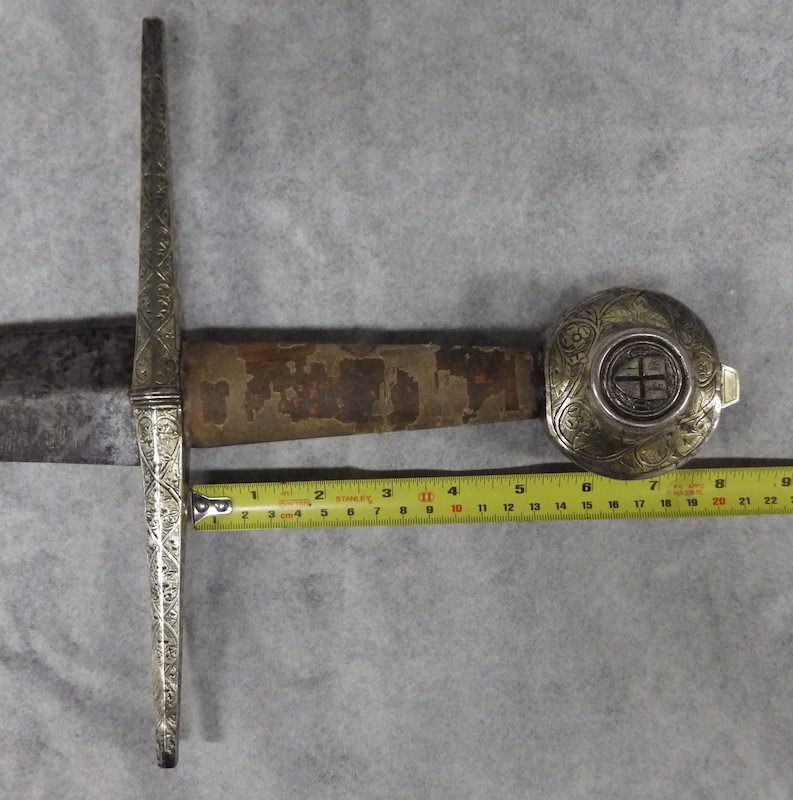
 Attachment: 146.24 KB Attachment: 146.24 KB
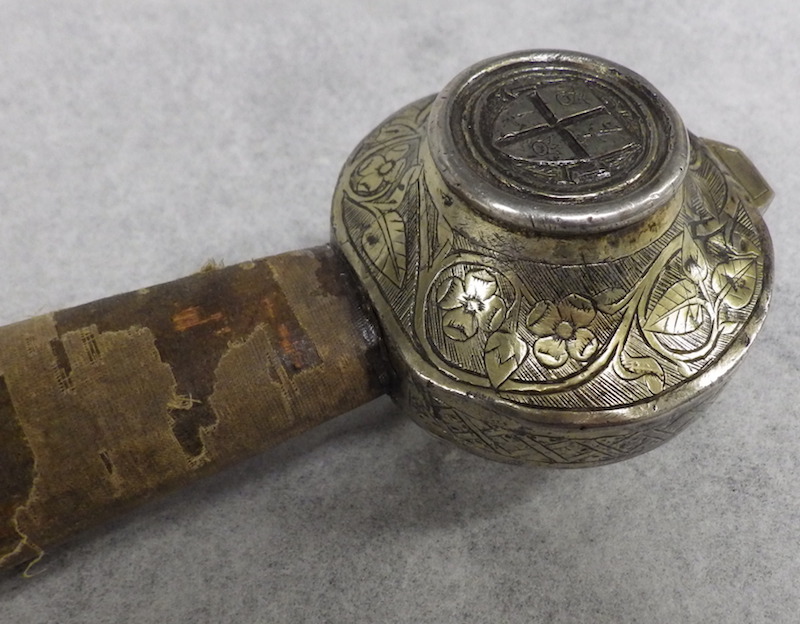
 Attachment: 139.78 KB Attachment: 139.78 KB
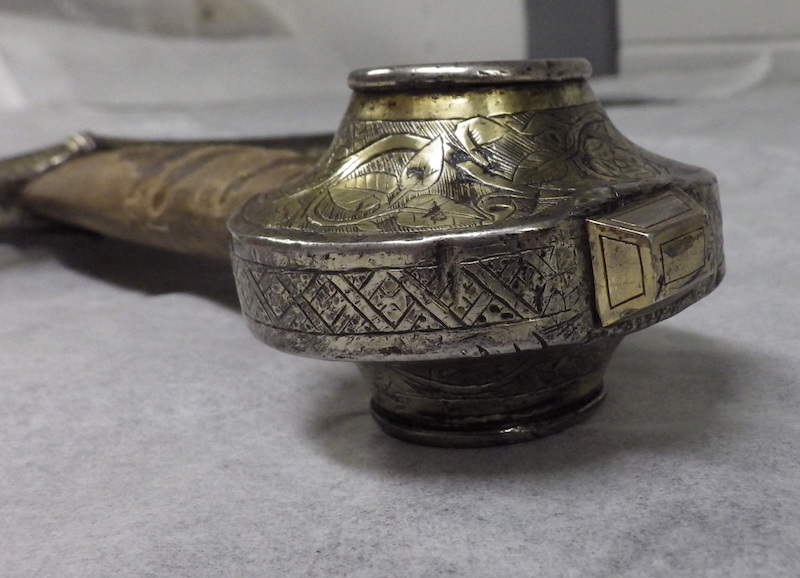
 Attachment: 130.84 KB Attachment: 130.84 KB
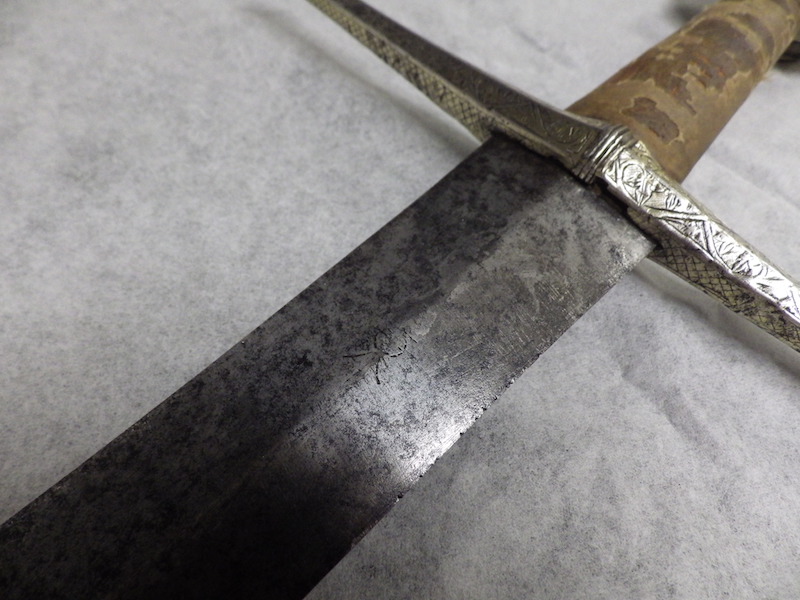
 Attachment: 173.68 KB Attachment: 173.68 KB
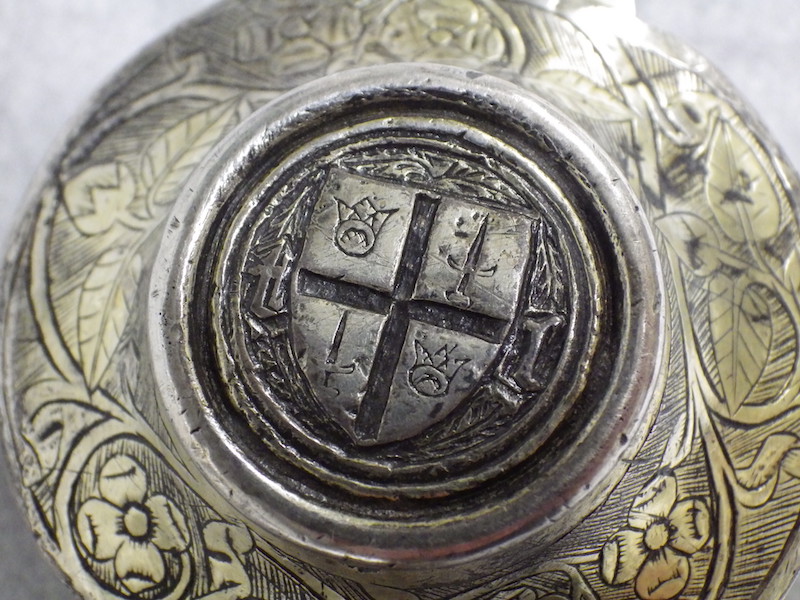
 Attachment: 130.59 KB Attachment: 130.59 KB
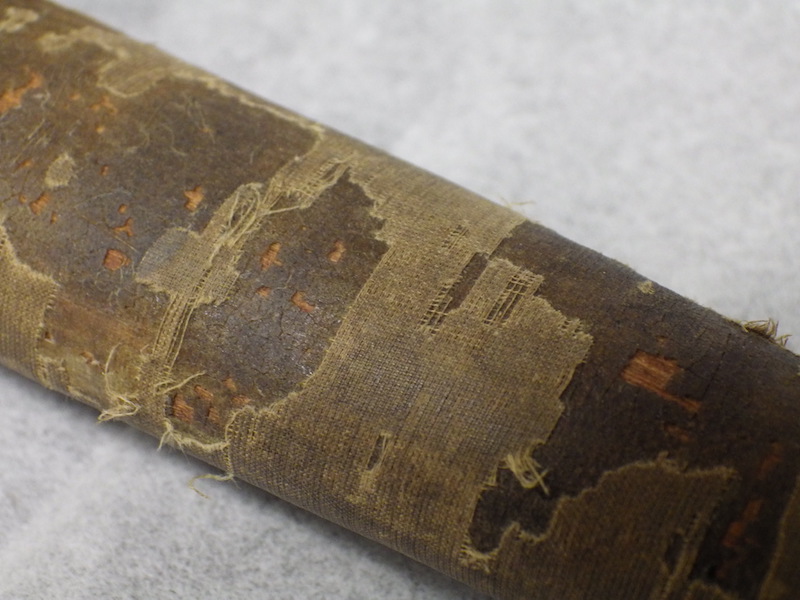
 Attachment: 42.03 KB Attachment: 42.03 KB

 Attachment: 207.3 KB Attachment: 207.3 KB
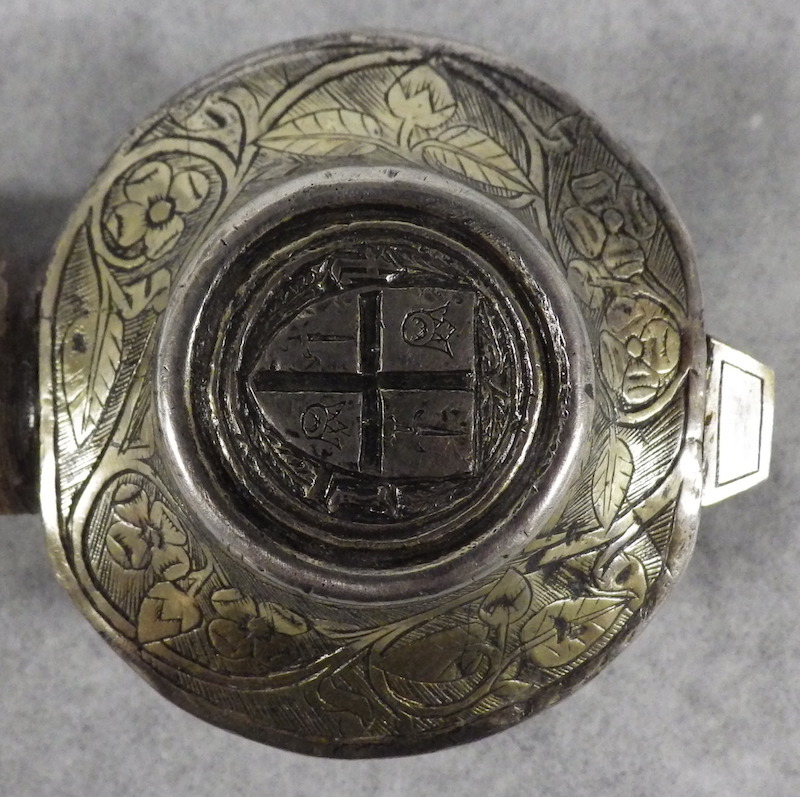
 Attachment: 144.48 KB Attachment: 144.48 KB
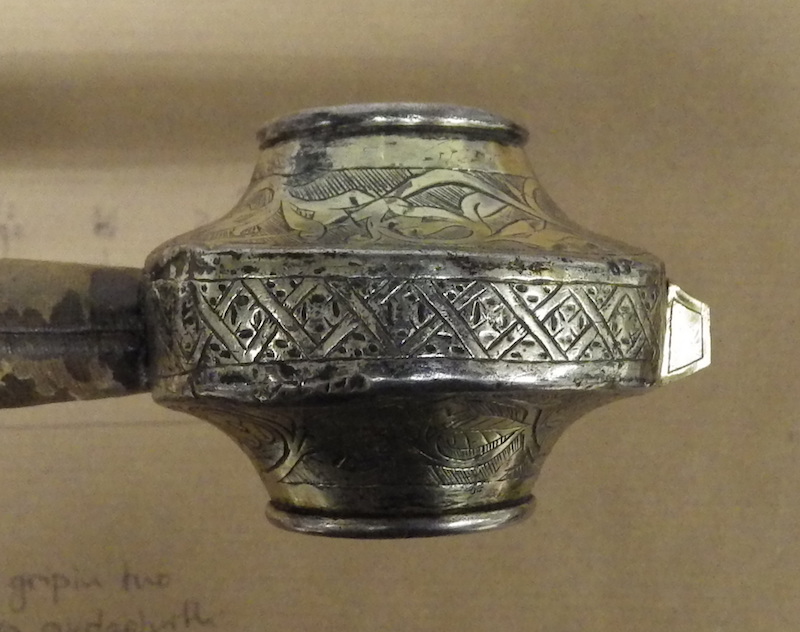
www.todsworkshop.com
www.todcutler.com
www.instagram.com/todsworkshop
https://www.facebook.com/TodsWorkshop
www.youtube.com/user/todsstuff1
|
|
   |
 |
Guillaume Vauthier

|
 Posted: Fri 10 Feb, 2017 4:41 am Post subject: Posted: Fri 10 Feb, 2017 4:41 am Post subject: |
 |
|
Beautiful sword! I can't wait to see your reproduction.
It is interesting to see that, in terms of dimensions, this sword is kinda close to a sword kept in the Musée de l'Armée. The lengths that you give are quite the same:

The sword is by the way of the early 15th century. That's personnally what I use to call a bastard sword: a long single-hander, with a long enough handle to be used with one hand in a gauntlet, or with both hands with bare hands or thin leather gloves. But I guess everyone has his own definition 
|
|
  |
 |
Julien M

|
 Posted: Fri 10 Feb, 2017 5:45 am Post subject: Posted: Fri 10 Feb, 2017 5:45 am Post subject: |
 |
|
Amazing sword! Thanks for sharing Leo. The engraving is exquisite on both guard and pommel.
Looking forward to see your repro!
|
|
  |
 |
|
Mark Moore
|
 Posted: Fri 10 Feb, 2017 6:46 am Post subject: Posted: Fri 10 Feb, 2017 6:46 am Post subject: |
 |
|
Indeed! This will be fascinating to see come to life! With those specs on the blade you gave, Thomas de L. must have had a pretty good arm on him!  .......McM .......McM
''Life is like a box of chocolates...'' --- F. Gump
|
|
  |
 |
|
Peter Lyon
Industry Professional
|
 Posted: Fri 10 Feb, 2017 11:34 am Post subject: Posted: Fri 10 Feb, 2017 11:34 am Post subject: |
 |
|
What a wonderful commission to get to do! A real fighting sword (not just a showpiece) but highly detailed too.
Are you sure the pommel is solid? It was common for the peaked pieces to be applied to a disc pommel, leaving voids each side, and I think I can detect in the final photo, join lines that have become a bit munched.
Looking forward to progress photos on this one.
Still hammering away
|
|
  |
 |
Leo Todeschini
Industry Professional

|
 Posted: Fri 10 Feb, 2017 12:15 pm Post subject: Posted: Fri 10 Feb, 2017 12:15 pm Post subject: |
 |
|
Thanks for the interest guys.
Peter Lyon wrote | Quote: | | Are you sure the pommel is solid? It was common for the peaked pieces to be applied to a disc pommel, leaving voids each side, and I think I can detect in the final photo, join lines that have become a bit munched. |
Actually I can't be sure without some some serious maths, because the pommel is iron (presumably like the guard) and is then covered in solid silver plates, so any seam you see will be the silver, not the iron beneath. The other aspect is that I saw the size of the pommel as it lay there before picking it up and assumed it was hollow, but on picking it up, it was like holding a truck and just as responsive.
Curious and as Mark says 'This guy had big arms'
Tod
www.todsworkshop.com
www.todcutler.com
www.instagram.com/todsworkshop
https://www.facebook.com/TodsWorkshop
www.youtube.com/user/todsstuff1
|
|
   |
 |
Craig Peters

|
 Posted: Fri 10 Feb, 2017 9:23 pm Post subject: Posted: Fri 10 Feb, 2017 9:23 pm Post subject: |
 |
|
|
How certain is it that this is a genuine 15th century sword? The reason I ask is that, appearance-wise, some of the details look like what you might find on a better Victorian/19th century reproduction. Aside from being part of the Meyrick Collection, is there any earlier provenance details?
|
|
  |
 |
Michael Harley

|
 Posted: Fri 10 Feb, 2017 9:56 pm Post subject: Posted: Fri 10 Feb, 2017 9:56 pm Post subject: |
 |
|
Hi Leo,
Are you aware of this article from 'Proceedings of the Society of Antiquaries of Scotland. Ninety-Fourth Session, 1873-74, Vol. X-Part II' in which it is stated the handle is a nineteenth century addition?
 Attachment: 357.79 KB Attachment: 357.79 KB
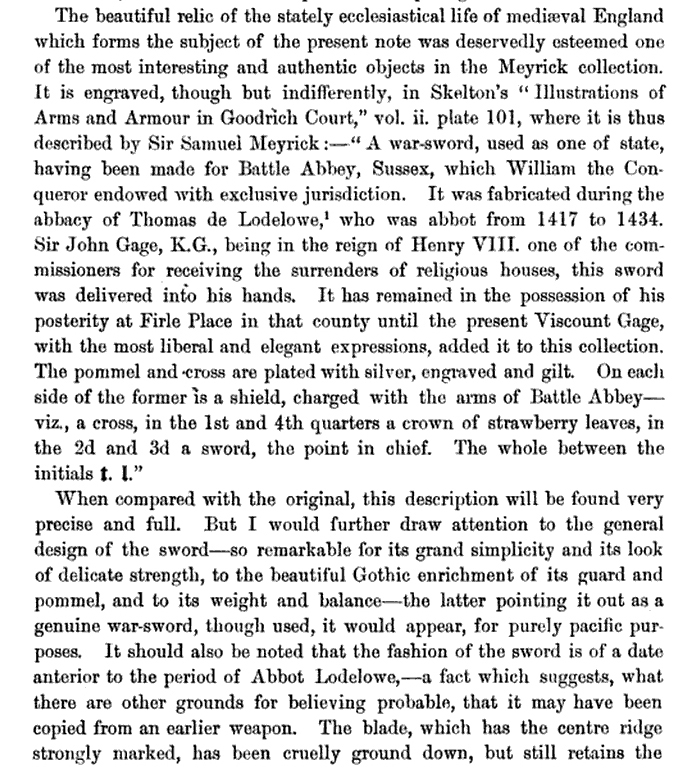
 Attachment: 310.01 KB Attachment: 310.01 KB
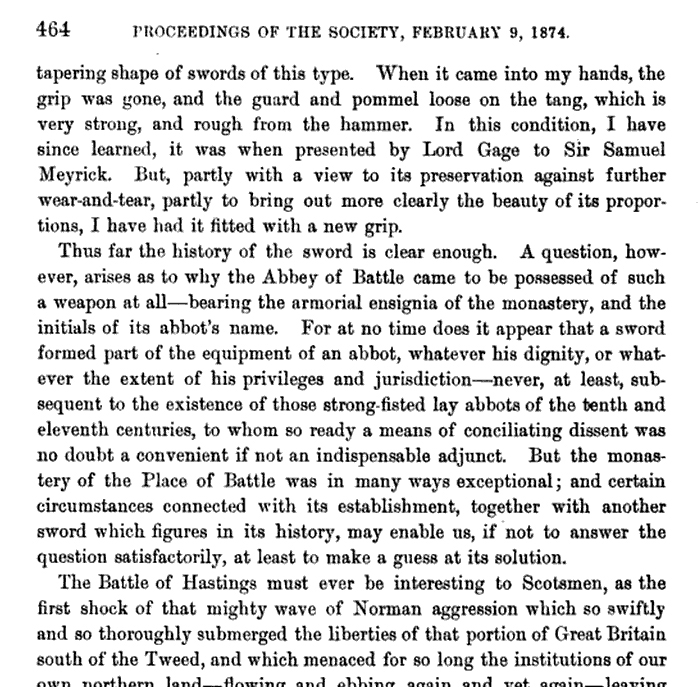
 Attachment: 14.97 KB Attachment: 14.97 KB
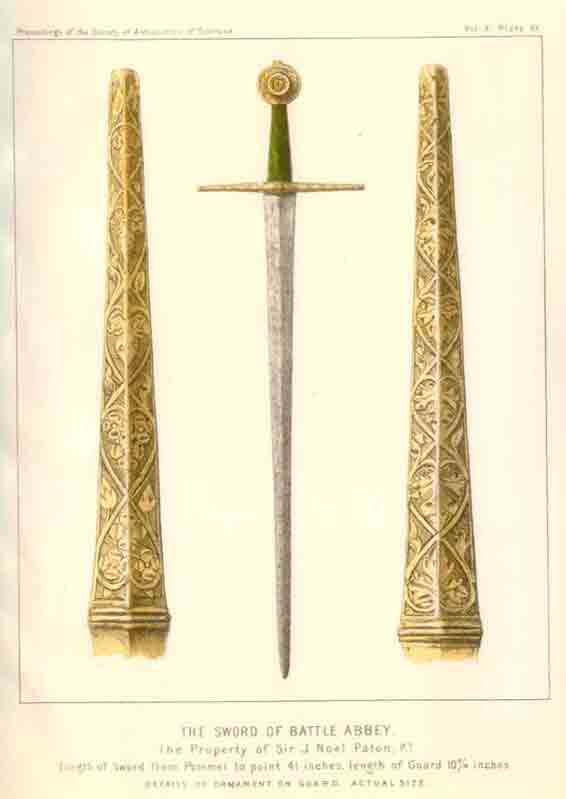
 Attachment: 20.1 KB Attachment: 20.1 KB
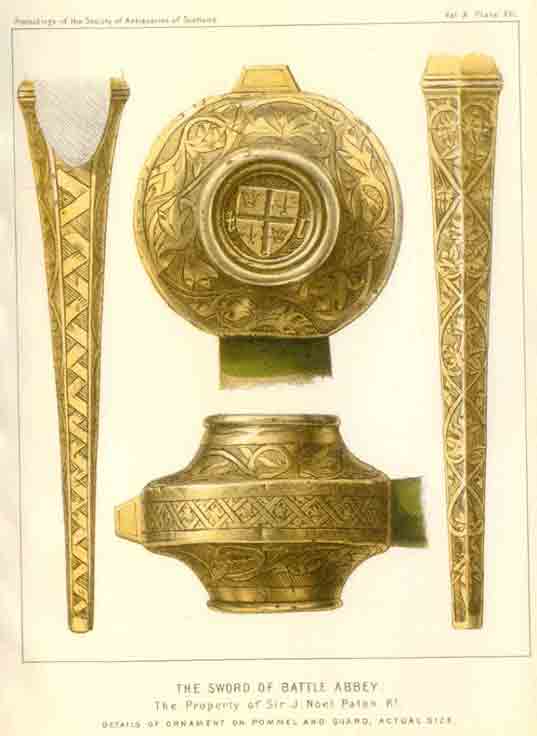
Information is not knowledge, Knowledge is not wisdom, Wisdom is not truth - Frank Zappa
|
|
   |
 |
Craig Peters

|
 Posted: Sat 11 Feb, 2017 12:59 am Post subject: Posted: Sat 11 Feb, 2017 12:59 am Post subject: |
 |
|
Beyond just the grip, there is something odd about the sword. The overly ornate hilt looks like something out of the 19th century particularly with the coat of arms and the additional gilt metalwork. Although there are some 15th century swords like this, it feels like the whole thing is dressed up too much, especially with the detail of the initials alongside everything else. The coat of arms and the initials seems like something a modern person would want to do so as to prove the sword can be linked to Thomas de Lodelowe.
The blade seems "off" as well. Even visually, there's something about it that makes me doubt it is medieval. Further, Tod mentioned that the blade is only 32 inches making it slightly shorter than the blade on a reproduction sword like Albion's Castellan, Mercenary or Constable. Yet Tod notes that it is "notably heavy and stiff". A sword that is either a single handed sword or a very short long sword (bastard sword) need not be particularly heavy. With a diamond-looking cross section, it would be easy to have a blade that is cumbersome and too heavy, provided the blade smith was not aware of the need to make a comparatively thin blade in cross-section with good distal taper to the point, especially if that person was a modern forger. There is nothing about this sword that should suggest heavy or cumbersome if it is a genuine sword, and yet it seems to be.
To me, too much seems fishy to trust that it is a genuine sword. It has several hallmarks of a fake.
|
|
  |
 |
Leo Todeschini
Industry Professional

|
|
   |
 |
|
Mark Moore
|
 Posted: Sat 11 Feb, 2017 6:50 am Post subject: Posted: Sat 11 Feb, 2017 6:50 am Post subject: |
 |
|
Genuine OR fake, I'd like to see this sword re-made. I'm sure Tod can put his own personal spin on it, but still have it fairly true to the example...just 'Todified'. (Yes, folks...There's your new word....Todified.)   .....McM .....McM
''Life is like a box of chocolates...'' --- F. Gump
|
|
  |
 |
Antal László

|
 Posted: Sat 11 Feb, 2017 10:06 am Post subject: Posted: Sat 11 Feb, 2017 10:06 am Post subject: |
 |
|
| Mark Moore wrote: | Genuine OR fake, I'd like to see this sword re-made. I'm sure Tod can put his own personal spin on it, but still have it fairly true to the example...just 'Todified'. (Yes, folks...There's your new word....Todified.)   .....McM .....McM |
I totally agree with the above. It would be nice to know the definite origin of the sword, but at this point it doesn't really matter. It's a job to recreate an item associated with Battle Abbey and I'm glad they commissioned Tod to do this. I too like 'Todified' stuff 
I hope he'll post WIP pics...
I do among other things 3D CAD and as a quick modelling exercise I threw together a solidworks model based on the measurements Tod posted. In Solidworks you can specify the material and you get mass properties like weight and centre of mass.
The weight came to nearly 2kg... Most of the dimensions for the CAD model were just eyeballed but it shouldn't be too far off. I'm curious what the finished weight of Tod's reproduction will be. Interestingly the centre of mass ended up at just above the guard.
 Attachment: 274.12 KB Attachment: 274.12 KB
The weight in pounds is about 4.25 lbs [ Download ]
|
|
   |
 |
|
Peter Lyon
Industry Professional
|
 Posted: Sat 11 Feb, 2017 10:12 am Post subject: Posted: Sat 11 Feb, 2017 10:12 am Post subject: |
 |
|
This will of course be a difficult piece to reproduce because of the engraving and the plating, but in fact this has steered me in a certain way. I would love to have made this as the original was, but unfortunately the original was fire gilded which is nit open to me now, so I would have to electro plate the gold. However the various solutions required during the process will go into wherever there are voids under the silver (and whatever I do, there will be some) and will cause problems, so I have decided that the pieces have to be solid to ensure a good gold plate."
Are you sure you can't Mercury gild? I've been reading a 1970s German jewellery textbook and it describes MG in that as a current process. I know H&S has totally changed in the last 50 years, but is it still possible to MG in a fume cupboard? That would allow you to copy the process of the original more closely.
Still hammering away
|
|
  |
 |
|
Peter Johnsson
Industry Professional
|
 Posted: Sat 11 Feb, 2017 10:30 am Post subject: Posted: Sat 11 Feb, 2017 10:30 am Post subject: |
 |
|
I remember seeing this sword in Edinburgh an being struck by how massive it is.
If you might share blade width & guard height, I could make a preliminary analysis of its proportions. When I now see the sword I cannot escape the impression that it may be shortened? The article speaks about the sword being "cruelly ground down". That might be a remark of it being shortened?
It would be interesting to see how it compares in proportions to siblings of similar type. Some clues might be had, that way.
(Personally, I have no doubt in my mind it is an original sword from the early 15th century, or late 14th century)
|
|
   |
 |
Victor R.

|
 Posted: Sat 11 Feb, 2017 11:25 am Post subject: Posted: Sat 11 Feb, 2017 11:25 am Post subject: |
 |
|
When noting that the dimensions of the sword seem to be at the upper end of functional, or at least what one would consider "normal" - grip longer than normal single-hand, but too short for "bastard" dimensions, heavy blade of generally single-hand length, large grip (which, based on the article provided seems to be a later period repair/restoration) - one question that comes to my mind is what were the dimensions of Thomas de Lodelowe, to whom the sword is attributed? Was his size well above average? If he were in the mid to upper six foot range and built like a linebacker, then a bit longer grip to accommodate larger-than-average hands and heavier blade might be reasonable.
One interpretation offered by Peter on the phrase "cruelly ground down" is that the sword was shortened and reshaped - when I read it, the phrase seemed to me to be referring simply to the central ridge being ground down, rather than the entirety of the sword. Had the blade been produced with the strong ridge, but they wanted to take some weight off, might this have been a solution, rather than fully changing the distal taper?
Another question that pops to mind about the grip length in light of the article - when the grip was repaired and the loose pommel and guard tightened, might it have been re-peened, knocking off a 1/4" - 1/2" off of the length in the process? (Yes, I realize this is a point contrary to the "big hands" suggestion above, but could fit with Peter's "ground down = shortened" proposition.)
As for the CAD reproduction (very cool application of technology for diagnostic purposes  ), if that balance point is accurate, then, even at the weight, it would seem that the sword would handle well and feel lighter in use than when simply holding and handling for examination. ), if that balance point is accurate, then, even at the weight, it would seem that the sword would handle well and feel lighter in use than when simply holding and handling for examination.
Interesting piece that raises many questions. Should be fun to see Tod's progress to completion and see others' thoughts on some of these questions that we are raising. A question to Tod: will your mark be visible, or hidden away on the tang? 
|
|
  |
 |
|
Peter Johnsson
Industry Professional
|
 Posted: Sat 11 Feb, 2017 11:43 am Post subject: Posted: Sat 11 Feb, 2017 11:43 am Post subject: |
 |
|
Something like this perhaps?
The projected length would indicate an original length of 96,5 cm. A bit on the long side, but would go well with the dimension and proportions of the hilt and the massive pommel.
Tod, is the blade width something like 5.4 cm?
 Attachment: 25 KB Attachment: 25 KB
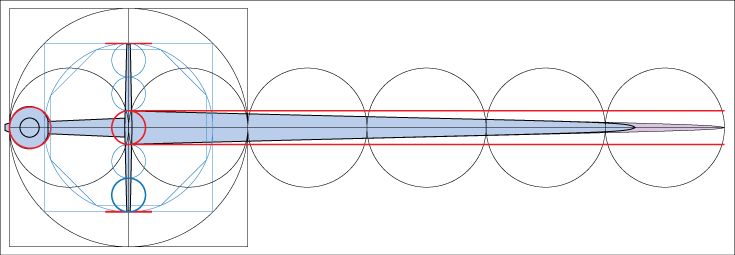
Last edited by Peter Johnsson on Sat 11 Feb, 2017 12:03 pm; edited 2 times in total
|
|
   |
 |
Glen A Cleeton

|
 Posted: Sat 11 Feb, 2017 11:48 am Post subject: Posted: Sat 11 Feb, 2017 11:48 am Post subject: |
 |
|
Fire/amalgam gilding is still practiced, mostly in the jewelry trade. To set up to epa standards would be cost prohibitive unless doing it a lot and location comes into it as well. Some hobbyists tinker but they would be flaunting the law and could face serious fines. I would say if it has to be fire gilt, farm it out.
Could do a fusion technique with sheet and heat but that is for surfaces vs detail. Basically brazing gold to other metal. Carve through the gold to reveal the other.
Cheers
GC
|
|
  |
 |
Nathan Robinson
myArmoury Admin


|
|
    |
 |
|
Peter Johnsson
Industry Professional
|
 Posted: Sat 11 Feb, 2017 1:01 pm Post subject: Posted: Sat 11 Feb, 2017 1:01 pm Post subject: |
 |
|
...Or like this, with only a minimal lengthening. The proposed blade length would then be 86.8 cm
 Attachment: 28.27 KB Attachment: 28.27 KB

Last edited by Peter Johnsson on Sat 11 Feb, 2017 1:16 pm; edited 1 time in total
|
|
   |
 |
Julien M

|
 Posted: Sat 11 Feb, 2017 1:06 pm Post subject: Posted: Sat 11 Feb, 2017 1:06 pm Post subject: |
 |
|
|
Same here, either the blade strikes me as being too short, or the quillons too long - but proportions feel definitely off. The hilt is so splendid and unusual that I'd go over it if left as is it, but the longer blade would make a huge difference in overall aesthetics and balance. Beside the thorpe falchion, I have not seen any wheel pommels so extensively decorated...very beautiful indeed.
|
|
  |
 |
|
|
You cannot post new topics in this forum
You cannot reply to topics in this forum
You cannot edit your posts in this forum
You cannot delete your posts in this forum
You cannot vote in polls in this forum
You cannot attach files in this forum
You can download files in this forum
|
All contents © Copyright 2003-2025 myArmoury.com — All rights reserved
Discussion forums powered by phpBB © The phpBB Group
Switch to the Basic Low-bandwidth Version of the forum
|

